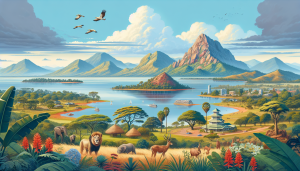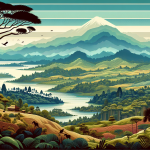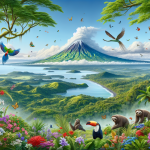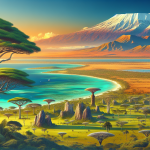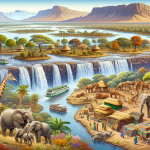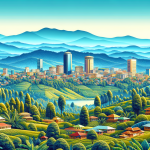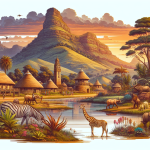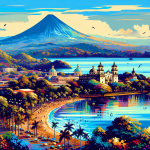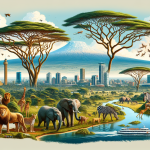Exploring the Hidden Gem of Africa: Malawi
Malawi, often referred to as the “Warm Heart of Africa,” is an enchanting destination that remains relatively unexplored by mainstream tourists. This landlocked country in southeastern Africa is brimming with breathtaking landscapes, a rich cultural tapestry, and a unique blend of wildlife and natural beauty that promises an unforgettable experience. Malawi stretches along the western side of Lake Malawi, one of the largest and most beautiful lakes in the world. The country is bordered by Zambia to the northwest, Tanzania to the northeast, and Mozambique to the east, south, and west. Despite its small size, Malawi boasts a diverse range of attractions, from the crystal-clear waters of Lake Malawi to the rolling highlands of Nyika National Park. Visitors can immerse themselves in the vibrant local culture, explore historical sites, and enjoy a variety of outdoor activities. Whether you’re an adventure seeker, a nature enthusiast, or someone simply looking to unwind in a serene environment, Malawi has something to offer. This article delves into the many facets of Malawi, providing an in-depth guide to help you plan your visit and experience the best this beautiful country has to offer.
Lake Malawi: The Jewel of the Nation
Lake Malawi, also known as Lake Nyasa in Tanzania and Lago Niassa in Mozambique, is the third largest lake in Africa and the ninth largest in the world. This expansive body of water covers over 29,600 square kilometers and stretches about 580 kilometers from north to south. Known for its crystal-clear waters and diverse marine life, Lake Malawi is often referred to as the “Calendar Lake” because it is approximately 365 miles long and 52 miles wide. The lake is part of the Great Rift Valley and is home to more species of fish than any other lake in the world, making it a prime destination for snorkeling and scuba diving enthusiasts. Visitors can explore the lake’s numerous beaches, islands, and picturesque fishing villages, each offering a unique glimpse into the local way of life. Popular activities around Lake Malawi include kayaking, sailing, and bird watching. The lake’s shoreline is dotted with several lodges and resorts, providing comfortable accommodations for visitors seeking both adventure and relaxation.
Snorkeling and Diving in Lake Malawi
One of the main attractions of Lake Malawi is its incredible underwater biodiversity. The lake is home to over 1,000 species of cichlid fish, many of which are endemic to the lake. This makes it a paradise for snorkeling and diving enthusiasts. The clear waters of the lake allow for excellent visibility, providing a fascinating glimpse into the vibrant underwater world. Several dive centers around the lake offer PADI-certified courses and guided dives, catering to both beginners and experienced divers. Popular dive sites include the rocky outcrops and underwater caves near Cape Maclear, the colorful coral gardens near Likoma Island, and the shipwrecks scattered along the lake’s bottom. Snorkeling is also a popular activity, with many lodges and resorts providing equipment and organizing guided snorkeling trips. Whether you’re a seasoned diver or a novice snorkeler, exploring the underwater world of Lake Malawi is an experience not to be missed.
Kayaking and Sailing on Lake Malawi
For those who prefer to stay above the water, kayaking and sailing are excellent ways to explore Lake Malawi. The lake’s calm waters and gentle breezes provide ideal conditions for both activities. Kayaking allows you to get up close to the lake’s beautiful shoreline, explore hidden coves, and visit remote fishing villages. Many lodges and resorts around the lake offer kayak rentals and guided kayaking tours, catering to all skill levels. Sailing is another popular activity on Lake Malawi, with several operators offering sailing trips aboard traditional wooden dhows or modern sailboats. These trips provide a unique perspective of the lake and its surroundings, allowing you to relax and soak in the stunning scenery. Whether you’re paddling through the clear waters or cruising under sail, exploring Lake Malawi by kayak or sailboat is a memorable experience.
Nyika National Park: A Highland Wonderland
Nyika National Park is Malawi’s largest park, covering an area of over 3,200 square kilometers. Located in the northern part of the country, the park is characterized by its rolling highlands, lush grasslands, and montane forests. Nyika, which means “where the water comes from,” is a haven for wildlife enthusiasts and nature lovers. The park is home to a diverse range of fauna, including large herds of antelope, zebras, leopards, and over 400 species of birds. The park’s varied terrain and abundant wildlife make it an ideal destination for game drives, hiking, and bird watching. Visitors can explore the park’s extensive network of trails, which offer stunning views of the surrounding landscape and opportunities to spot wildlife in their natural habitat. Nyika National Park also boasts several lodges and campsites, providing comfortable accommodations for visitors looking to immerse themselves in the park’s natural beauty.
Game Drives and Wildlife Viewing
Game drives are one of the main attractions of Nyika National Park, offering visitors the chance to see a wide range of wildlife in their natural habitat. The park’s open grasslands and rolling hills provide excellent visibility, making it easier to spot animals. Popular sightings include eland, roan antelope, zebras, and bushbucks. The park is also home to predators such as leopards and hyenas, although they are more elusive. Guided game drives are available through the park’s lodges and campsites, with knowledgeable guides providing insights into the park’s flora and fauna. Night drives are also offered, providing a unique opportunity to see nocturnal animals and experience the park’s nightlife. Whether you’re a seasoned safari-goer or a first-time visitor, a game drive in Nyika National Park is an unforgettable experience.
Hiking and Bird Watching
Nyika National Park is a hiker’s paradise, with a network of trails that traverse the park’s diverse landscapes. From short walks to multi-day treks, there are hiking options to suit all fitness levels and interests. Popular trails include the Chowo-Rumphi Trail, which offers stunning views of the park’s highlands and valleys, and the Chelinda-Chisanga Falls Trail, which leads to a picturesque waterfall. The park’s varied terrain and rich biodiversity make hiking a rewarding experience, with opportunities to spot wildlife and enjoy the pristine natural surroundings. Bird watching is another popular activity in Nyika National Park, with over 400 species of birds recorded in the park. Highlights include the endemic Nyika cisticola, the Denham’s bustard, and the stunning scarlet-tufted malachite sunbird. Whether you’re hiking through the highlands or bird watching in the montane forests, Nyika National Park offers a wealth of natural beauty to explore.
Liwonde National Park: A Wildlife Haven
Liwonde National Park is one of Malawi’s premier wildlife destinations, located in the southern part of the country along the Shire River. The park covers an area of approximately 548 square kilometers and is known for its diverse ecosystems, including riverine forests, floodplains, and mopane woodlands. Liwonde National Park is home to a wide range of wildlife, including elephants, hippos, crocodiles, and a variety of antelope species. The park is also a haven for bird watchers, with over 400 species of birds recorded. Visitors to Liwonde can enjoy a variety of activities, including game drives, boat safaris, and walking safaris. The park is easily accessible from the nearby town of Liwonde, and several lodges and campsites offer comfortable accommodations for visitors.
Game Drives and Boat Safaris
Game drives in Liwonde National Park offer visitors the chance to see a diverse range of wildlife in their natural habitat. The park’s varied ecosystems provide excellent opportunities for wildlife viewing, with popular sightings including elephants, hippos, and antelope. The park is also home to a growing population of black rhinos, thanks to successful conservation efforts. Guided game drives are available through the park’s lodges and campsites, with knowledgeable guides providing insights into the park’s flora and fauna. Boat safaris on the Shire River are another highlight of Liwonde National Park, offering a unique perspective of the park and its wildlife. Visitors can cruise along the river, spotting hippos, crocodiles, and a variety of bird species. Whether you’re exploring the park by land or water, Liwonde National Park offers a rich and rewarding wildlife experience.
Walking Safaris and Bird Watching
Walking safaris in Liwonde National Park provide an intimate and immersive way to experience the park’s natural beauty. Led by experienced guides, these safaris offer the chance to explore the park’s diverse ecosystems on foot, learning about the flora and fauna along the way. Walking safaris are particularly popular for bird watching, with the park’s riverine forests and floodplains providing excellent habitats for a variety of bird species. Highlights include the African fish eagle, the Pel’s fishing owl, and the saddle-billed stork. Whether you’re on a walking safari or a dedicated bird watching tour, Liwonde National Park offers a wealth of opportunities to connect with nature and experience the park’s rich biodiversity.
Mount Mulanje: The Island in the Sky
Mount Mulanje, also known as the Mulanje Massif, is a majestic mountain range located in southern Malawi. Known as the “Island in the Sky,” Mount Mulanje rises dramatically from the surrounding plains, with its highest peak, Sapitwa, reaching an elevation of 3,002 meters. The mountain is a popular destination for hiking and climbing, offering a range of trails and routes to suit all levels of experience. The diverse landscapes of Mount Mulanje, including lush forests, rocky outcrops, and cascading waterfalls, provide a stunning backdrop for outdoor adventures. The mountain is also home to a variety of flora and fauna, including several endemic plant species and a rich birdlife. Whether you’re an experienced climber or a casual hiker, Mount Mulanje offers a rewarding and challenging experience.
Hiking and Climbing Mount Mulanje
Hiking and climbing are the main attractions of Mount Mulanje, with a network of trails and routes that cater to all levels of experience. The mountain’s diverse landscapes provide a range of hiking experiences, from gentle walks through lush forests to challenging climbs up rocky peaks. Popular trails include the Lichenya Path, which offers stunning views of the mountain’s southern slopes, and the Chambe Basin Trail, which leads to the picturesque Chambe Basin. For those seeking a more challenging experience, the Mulanje Mountain Porter’s Trail offers a multi-day trek to the highest peak, Sapitwa. The mountain is also a popular destination for rock climbing, with several routes available for experienced climbers. Whether you’re hiking through the forest or climbing to the summit, Mount Mulanje offers a rewarding and unforgettable experience.
Flora and Fauna of Mount Mulanje
Mount Mulanje is home to a diverse range of flora and fauna, including several endemic plant species and a rich birdlife. The mountain’s unique ecosystems, ranging from montane forests to high-altitude grasslands, provide habitats for a variety of plant and animal species. Notable plant species include the Mulanje cedar, which is endemic to the mountain and is highly valued for its timber. The mountain is also home to a variety of bird species, making it a popular destination for bird watchers. Highlights include the endemic Mulanje bushshrike and the stunning green-headed oriole. Whether you’re exploring the mountain’s forests or its high-altitude grasslands, Mount Mulanje offers a wealth of natural beauty to discover.
Zomba Plateau: A Highland Retreat
The Zomba Plateau is a stunning highland area located in southern Malawi, near the town of Zomba. Rising to an elevation of 1,800 meters, the plateau offers a cool and refreshing escape from the lowland heat. The Zomba Plateau is known for its lush forests, scenic viewpoints, and cascading waterfalls, making it a popular destination for hiking, bird watching, and picnicking. The plateau’s diverse landscapes provide a range of outdoor activities, from gentle walks through the forest to challenging hikes up rocky peaks. Visitors can explore the plateau’s extensive network of trails, which offer stunning views of the surrounding countryside. The Zomba Plateau is also home to a variety of flora and fauna, including several endemic plant species and a rich birdlife. Whether you’re seeking adventure or relaxation, the Zomba Plateau offers a serene and beautiful retreat.
Hiking and Exploring the Zomba Plateau
Hiking is one of the main attractions of the Zomba Plateau, with a network of trails that cater to all levels of experience. The plateau’s diverse landscapes provide a range of hiking experiences, from gentle walks through lush forests to challenging climbs up rocky peaks. Popular trails include the Mulunguzi Dam Trail, which offers stunning views of the plateau’s southern slopes, and the Chingwe’s Hole Trail, which leads to a mysterious natural sinkhole. The plateau is also home to several scenic viewpoints, including Emperor’s View and Queen’s View, which offer panoramic views of the surrounding countryside. Whether you’re hiking through the forest or exploring the plateau’s rocky outcrops, the Zomba Plateau offers a rewarding and unforgettable experience.
Flora and Fauna of the Zomba Plateau
The Zomba Plateau is home to a diverse range of flora and fauna, including several endemic plant species and a rich birdlife. The plateau’s unique ecosystems, ranging from montane forests to high-altitude grasslands, provide habitats for a variety of plant and animal species. Notable plant species include the endemic Zomba cycad and the striking protea flower. The plateau is also a popular destination for bird watchers, with highlights including the endemic Thyolo alethe and the stunning blue swallow. Whether you’re exploring the plateau’s forests or its high-altitude grasslands, the Zomba Plateau offers a wealth of natural beauty to discover.
Malawi’s Rich Cultural Heritage
Malawi’s rich cultural heritage is an integral part of the country’s charm, offering visitors a unique insight into the local way of life. The country is home to a diverse range of ethnic groups, each with its own distinct traditions, languages, and customs. Visitors can experience Malawi’s cultural heritage through a variety of activities, including visiting traditional villages, attending cultural festivals, and exploring historical sites. The warm and welcoming nature of the Malawian people adds to the country’s appeal, making it a truly special destination. Whether you’re exploring the bustling markets of Lilongwe, visiting a traditional village in the countryside, or attending a vibrant cultural festival, Malawi’s rich cultural heritage offers a wealth of experiences to discover.
Visiting Traditional Villages
Visiting traditional villages is a great way to experience Malawi’s cultural heritage and learn about the local way of life. Many villages welcome visitors and offer guided tours, providing insights into traditional customs, crafts, and daily activities. Visitors can see traditional thatched-roof houses, watch demonstrations of traditional crafts such as pottery and weaving, and participate in cultural activities such as dance and music. Popular villages to visit include the Mua Mission Village, which is known for its rich cultural heritage and beautiful wood carvings, and the Livingstonia Mission, which offers a glimpse into the country’s colonial history. Whether you’re exploring a traditional village or learning about local customs, visiting traditional villages is a rewarding and enriching experience.
Attending Cultural Festivals
Cultural festivals are an important part of Malawi’s cultural heritage, offering a vibrant and colorful celebration of the country’s traditions and customs. These festivals provide a unique opportunity to experience Malawian culture through music, dance, and traditional ceremonies. Popular festivals include the Lake of Stars Festival, which is held annually on the shores of Lake Malawi and features a diverse lineup of local and international musicians, and the Mulhako wa Alhomwe Festival, which celebrates the culture and traditions of the Alhomwe people. Whether you’re dancing to the rhythms of traditional drums or enjoying a performance by a local musician, attending a cultural festival in Malawi is an unforgettable experience.
Exploring Historical Sites
Malawi is home to a number of historical sites that offer a fascinating glimpse into the country’s past. These sites provide insights into Malawi’s colonial history, as well as its rich cultural heritage. Notable historical sites include the Chongoni Rock Art Area, which is a UNESCO World Heritage site and features ancient rock paintings that date back thousands of years, and the Livingstonia Mission, which was established by Scottish missionaries in the late 19th century. Visitors can also explore the historic town of Blantyre, which is named after the birthplace of the famous explorer David Livingstone and is home to several colonial-era buildings. Whether you’re exploring ancient rock art or visiting a historic mission, Malawi’s historical sites offer a wealth of experiences to discover.
Practical Information for Visiting Malawi
Planning a trip to Malawi requires some practical considerations to ensure a smooth and enjoyable experience. The country is relatively easy to navigate, with a range of transportation options available, including buses, taxis, and rental cars. The main international gateway to Malawi is Lilongwe International Airport, which is located near the capital city of Lilongwe. Several airlines offer direct flights to Lilongwe from major cities in Africa and Europe. Visitors to Malawi are required to have a valid passport and may need a visa, depending on their nationality. It is recommended to check the visa requirements before traveling. The official language of Malawi is English, and the local currency is the Malawian kwacha. The country has a tropical climate, with the dry season running from May to October and the rainy season from November to April. The best time to visit Malawi is during the dry season when the weather is pleasant and ideal for outdoor activities.
In conclusion, Malawi is a hidden gem that offers a wealth of natural beauty, cultural heritage, and outdoor adventures. From the crystal-clear waters of Lake Malawi to the rolling highlands of Nyika National Park, the country boasts a diverse range of attractions that cater to all interests and preferences. Whether you’re snorkeling in Lake Malawi, hiking in Nyika National Park, or exploring traditional villages, Malawi promises an unforgettable experience. With its warm and welcoming people, rich cultural heritage, and stunning landscapes, Malawi truly lives up to its reputation as the “Warm Heart of Africa.”
For additional information and travel tips on visiting Malawi, you can check out [Lonely Planet’s guide to Malawi](https://www.lonelyplanet.com/malawi).
